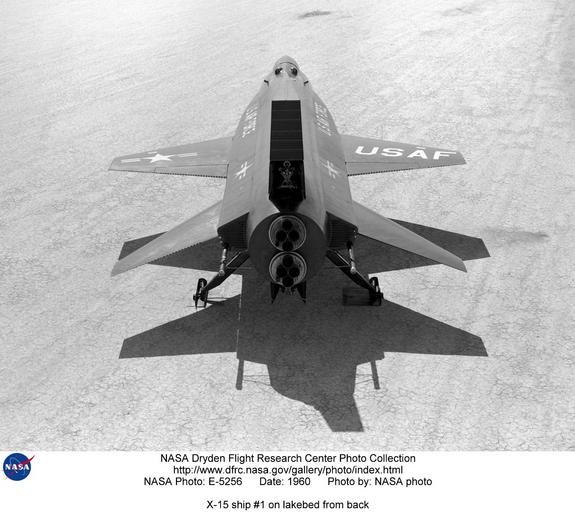MAKE A MEME
View Large Image

| View Original: | X-15_ship_-1_on_lakebed_from_back_DVIDS681721.jpg (1536x1367) | |||
| Download: | Original | Medium | Small | Thumb |
| Courtesy of: | commons.wikimedia.org | More Like This | ||
| Keywords: X-15 ship -1 on lakebed from back DVIDS681721.jpg en The X-15 56-6670 seen here on the lakebed at Edwards Air Force Base Edwards California was still equipped with two XLR-11 engines pending installation of the XLR-99 engine which first flew on November 15 1960 in X-15 2 The X-15 was a rocket-powered aircraft 50 ft long with a wingspan of 22 ft It was a missile-shaped vehicle with an unusual wedge-shaped vertical tail thin stubby wings and unique fairings that extended along the side of the fuselage The X-15 weighed about 14 000 lb empty and approximately 34 000 lb at launch The XLR-99 rocket engine manufactured by Thiokol Chemical Corp was pilot controlled and was capable of developing 57 000 lb of rated thrust actual thrust reportedly climbed to 60 000 lb North American Aviation built three X-15 aircraft for the program The X-15 research aircraft was developed to provide in-flight information and data on aerodynamics structures flight controls and the physiological aspects of high-speed high-altitude flight A follow-on program used the aircraft as a testbed to carry various scientific experiments beyond the Earth's atmosphere on a repeated basis For flight in the dense air of the usable atmosphere the X-15 used conventional aerodynamic controls such as rudder surfaces on the vertical stabilizers to control yaw and canted horizontal surfaces on the tail to control pitch when moving in synchronization or roll when moved differentially For flight in the thin air outside of the appreciable Earth's atmosphere the X-15 used a reaction control system Hydrogen peroxide thrust rockets located on the nose of the aircraft provided pitch and yaw control Those on the wings provided roll control Because of the large fuel consumption the X-15 was air launched from a B-52 aircraft at 45 000 ft and a speed of about 500 mph Depending on the mission the rocket engine provided thrust for the first 80 to 120 sec of flight The remainder of the normal 10 to 11 min flight was powerless and ended with a 200-mph glide landing Generally one of two types of X-15 flight profiles was used a high-altitude flight plan that called for the pilot to maintain a steep rate of climb or a speed profile that called for the pilot to push over and maintain a level altitude The X-15 was flown over a period of nearly 10 years--June 1959 to Oct 1968--and set the world's unofficial speed and altitude records of 4 520 mph Mach 6 7 and 354 200 ft over 67 mi in a program to investigate all aspects of piloted hypersonic flight Information gained from the highly successful X-15 program contributed to the development of the Mercury Gemini and Apollo manned spaceflight programs and also the Space Shuttle program The X-15s made a total of 199 flights and were manufactured by North American Aviation X-15-1 serial number 56-6670 is now located at the National Air and Space Museum Washington DC North American X-15A-2 serial number 56-6671 is at the United States Air Force Museum Wright-Patterson AFB Ohio The X-15-3 serial number 56-6672 crashed on 15 November 1967 resulting in the death of Maj Michael J Adams NASA Identifier NIX-E-5256 2009-09-23 Glenn Research Center https //www dvidshub net/image/681721 681721 2012-10-10 10 22 WASHINGTON DC US PD-USGov Aircraft at Rogers Dry Lake Images from DoD uploaded by Fæ North American X-15 | ||||